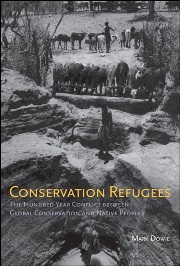
Conservation Refugees: The Hundred-Year Conflict between Global Conservation and Native Peoples
by Mark Dowie
-Reviewed by Jodie Liu
There is little question that the world’s biodiversity is dwindling rapidly – if the Earth continues to lose forests at its current rate, they may not survive past the 21st century.
But, according to Mark Dowie, conservation can have a dark side. As environmental scientists pursue conservation, indigenous people are often forced out of their homes and into refugee camps, many times with tragic results. In Conservation Refugees, Dowie challenges the conservationists by questioning their methods rather than dismissing their goals. While it is imperative to preserve what remains of wildlife, Dowie asks, shouldn’t the fate of the indigenous peoples at least be taken into consideration? That is, at which point should conservation biology draw the line for human rights?
As Dowie says, there are no real “bad guys” in the story of conservation refugees. On one side, conservationists are trying to save the world’s biological diversity, and on the other side, the indigenous people evicted from these lands are trying to save their longstanding livelihoods. Alternating between analysis of conservationist methods and exposition on various indigenous tribes around the world, Dowie investigates both sides of the conflict with an emphasis placed on the indigenous people turned “conservation refugees,” the underdogs in this ongoing struggle.
Dowie questions one of the fundamental assumptions of conservation: that there is a fixed, knowable “wilderness” to which we should aspire. The prevailing conservation biology definition of wilderness is not much more than a myth, Dowie writes. Yosemite National Park, the first and most famous of naturalist John Muir’s conservation projects, is one place that Dowie claims tries to actualize an unattainable ideal, playing perhaps on a degree of ignorance and snobbery. The wilderness of Yosemite is, he says, a “culturally constructed neo-Edenic narrative played out for the enchantment of weary human urbanites yearning for the open frontier, a place to absorb the sounds and images of virgin nature and forget for a moment the thoroughly unnatural lives they lead.” Like giving a rich man a taste of a poor man’s plight, a national park caters to resource-blessed people who have never been forced to utilize their immediate surroundings as their sole means of survival.
Indigenous tribes do use the lands they inhabit. As Dowie notes, humanity does not necessarily end where nature begins, and the indigenous tribe is no more invasive than, for instance, lions, the top predators in their ecosystem. In fact, Dowie shows that the Gimi tribe of Papua New Guinea has no concept of “nature” because they consider themselves to be nature. When members of the Gimi tribe die, it is believed that “their spirits go back to the forest and infuse themselves into the plans, animals and rivers.”
But indigenous tribes like the Miwok, the Maasai, and the Adivasai are more often perceived not as parts of nature but as “enemies of conservation,” Dowie asserts. To conservation biologists, indigenous tribes exploit the otherwise-untainted wilderness by utilizing nature for their own benefit. That they occupy land prevents conservationists from formally establishing protective measures within those lands.
But if conservationists do move indigenous people, Dowie argues, they’ve only traded a transgression on nature for a transgression on human rights. The Batwa, a tribe from the Bwindi Impenetrable Forest, now lives in “squalid” refugee camps “covered in human waste.” Some tribe members, Dowie finds, are so unfamiliar with norms of life outside the forest that they are often seen running into oncoming traffic. In another case, Dowie reveals how children of the Ashaninka tribe, displaced from the Brazilian rainforest, have dark reddish streaks from protein deficiency.
The resolution does not come handily, Dowie admits, but the key is to conserve consciously – protect the wilderness without mistreating indigenous tribes. And despite his sympathies with the conservation refugees, Dowie recognizes that sacrifice is required of both parties in the conservation struggle to achieve environmental and humanitarian justice.
Excerpt: “When, after setting aside a ‘protected’ land mass the size of Africa, global biodiversity continues to decline and the rate of species extinction approaches one-thousand times background levels, the message seems clear that there might be something terribly wrong with this plan, particularly after the Convention on Biological Diversity has documented the astounding fact that in Africa, where so many parks and reserves have been created and where indigenous evictions still run highest, 90 percent of biodiversity lies outside of protected areas, most of it in places occupied by human beings. If we really want people to live in harmony with nature, history is showing us that the dumbest thing we can do is kick them out of it.”
Further Reading: Hijacking Sustainability and Nature Unbound: Conservation, Capitalism and the Future of Protected Areas




Send A Letter To the Editors